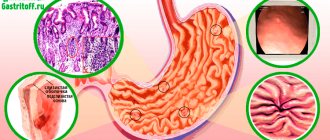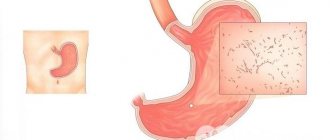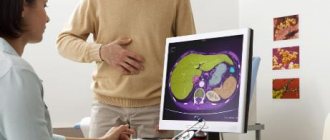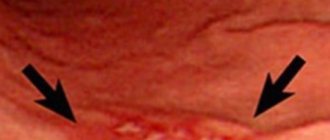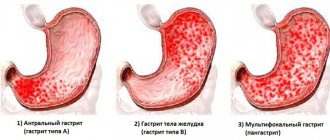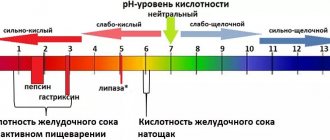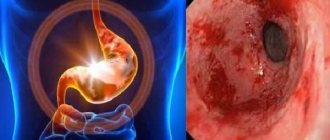Classification
Based on the course of the disease, clinicians distinguish:
- acute gastritis - can either develop independently with well-defined symptoms or be aggravated by an existing chronic disease;
- chronic antrum gastritis is an independent type of disease that lasts for a long period and is characterized by exacerbations.
According to the degree of damage and localization of the pathology, the following forms are distinguished:
- erosive;
- superficial antrum gastritis;
- focal;
- atrophic antrum gastritis;
- erythematous;
- grainy.
Signs of illness
With this disease, diarrhea is more characteristic than constipation.
The initial stages of antrum gastritis are mild, since only the surface layer is affected, and the glands are not yet affected, therefore, the digestive process is not disturbed. As the pathology develops, it manifests itself with the following symptoms:
- sharp pain, similar to an attack, localized in the epigastrium and often dependent on food intake and lasting 1-2 hours;
- heartburn and sour belching and taste in the mouth;
- nausea to the point of vomiting;
- flatulence, bloating;
- diarrhea, less often - constipation;
- tarry stools, vomiting with bloody impurities against the background of bleeding due to an erosive form of inflammation;
- loss of appetite to the point of refusing to eat;
- weakness, lethargy, loss of ability to work, chronic fatigue.
Symptoms
The general symptoms of the disease are vague. As the inflammatory process develops, the clinical picture may manifest itself in the form of the following symptoms:
- after eating there is a sharp pain in the epigastric region;
- sour belching;
- bad breath;
- nausea with vomiting;
- diarrhea;
- constipation;
- heartburn;
- bleeding;
- loss of appetite;
- weakness and fatigue.
Symptoms of antrum gastritis
Erosive antrum gastritis is similar in its symptoms to the catarrhal type of the disease. It is characterized by irritation of the gastric mucosa, which leads to erosion, damage to the glands, and scarring on the walls of the organ. Signs of this disease are manifested in:
- stabbing and aching pain in the upper abdomen;
- heartburn;
- reducing acidity levels;
- dyspeptic phenomena.
Erythematous gastritis is characterized by inflammation of the mucous membrane and redness of the walls of the organ. The patient's blood vessels may dilate and bleeding may occur.
Focal gastritis manifests itself in characteristic symptoms:
- non-acceptance of dairy products by the body;
- numbness of legs and arms;
- hair fragility and hair loss;
- pale skin;
- brittleness and splitting of nails.
Chronic antrum gastritis is, as a rule, a complication of the acute form of this disease. In more rare cases, it may be genetically determined. Expressed in the following signs:
- scars on the mucous membrane;
- reduction of the pyloric region;
- disorders of the small intestine;
- heaviness in the abdominal area;
- there is an unpleasant odor from the mouth;
- frequent belching;
- blood entering the stomach;
- poor appetite.
Antrum of the stomach
The antrum or outlet of the stomach is located below and occupies 1/3 of the entire area of the organ. This zone is lined with parietal cells, the specificity of which is the production of protective bicarbonate mucus, reducing the acidity of the incoming food bolus from the body of the stomach. As a result of the activity of the glands, food is prepared to enter the alkaline environment of the duodenum, and the mucous membrane is protected from the effects of aggressive acid.
With the development of antrum gastritis, the process of alkalization of the food bolus is disrupted, which provokes intestinal inflammation. Decreased production of protective bicarbonate mucus opens the glands to the aggressive effects of hydrochloric acid. As a result, the mucous membrane ulcerates with the further formation of rough scars from connective tissue structures that do not perform important digestive functions.
Diagnostics
What is antrum gastritis and how to treat it, only a specialized doctor knows. An accurate diagnosis can be established only after laboratory and instrumental examination. After a physical examination of the patient, the doctor sends the patient to:
- FGDS - insertion of a flexible tube with a camera into the stomach;
- X-ray;
- biopsy;
- blood test for infections;
- acidity test.
Treatment is prescribed only after an accurate diagnosis has been made. Unauthorized taking of medications or the use of traditional medicine is highly discouraged, as this can cause serious complications.
Forms of non-atrophic gastritis
Non-atrophic gastritis is a disease that has 3 forms, each of which manifests itself with its own symptoms and requires individual treatment. The doctor will be able to determine what form of the disease the patient is suffering from only after diagnosis.
- Focal gastritis of non-atrophic type. With this type of pathology, inflammation affects individual areas of the mucosa, and not the entire surface of the membrane, i.e. the disease manifests itself locally.
- Antral gastritis. This form is characterized by damage to the lower part of the stomach. Gradually, the inflammatory process from the antrum of the organ spreads to the duodenum.
- Chronic non-atrophic gastritis: not every patient who receives this diagnosis knows what it is. This form of pathology is caused by the bacterium Helicobacter pylori. The mucous membrane damaged by the disease is difficult to restore through regeneration.
Treatment
Treatment is usually complex. Most often, therapy combines medication, folk remedies and diet. First of all, treatment is aimed at destroying the Helicobacter pylori bacterium. Drug therapy includes the use of drugs with the following spectrum of action:
- antibiotics;
- antacids;
- painkillers;
- drugs aimed at restoring microflora.
Traditional medicine can be used after consultation with a doctor. To treat the disease, you can make tinctures from:
Pharmacy tincture of propolis
- calendula flowers;
- propolis.
Also, raw potato juice, aloe with honey, sea buckthorn and olive oils have a positive effect on the patient’s body.
In case of gastrointestinal pathology, the patient must adhere to a special diet and follow some rules:
- eat small portions 5-6 times a day;
- regulate food intake;
- eat only boiled and stewed foods;
- Wash vegetables and fruits thoroughly.
With gastritis affecting the antrum, it is prohibited to eat the following dishes:
- spicy;
- spicy;
- fried;
- highly salted;
- pickled;
- fast food;
- fresh vegetables.
You should also not eat grapes or baked goods. They promote fermentation in the stomach. The patient needs to give up coffee, strong tea, alcohol, and smoking forever.
The patient's diet should be based on the following dishes:
- soups from cereals, vegetables, with milk or water;
- lean meat, poultry, fish;
- dairy products;
- chopped steamed vegetables;
- porridge;
- sweet and not sour fruits;
- white bread, slightly dried;
- jelly, weak tea and compote.
Causes of the disease
There are a number of reasons why the disease develops. All of them participate in this process separately from each other or in combinations. These reasons include:
- Helicobacter pylori causes inflammation of the mucous membrane, atrophy of its areas appears;
- autoimmune causes. Due to the activity of the process of autoantibody synthesis, the destruction of the mucosal cells occurs;
- heredity;
- stressful situations;
- presence of bad habits;
- eating disorder;
- long-term use of antibiotics, non-steroidal anti-inflammatory drugs.
Symptomatic picture
In the early stages, the disease usually does not manifest itself. Symptoms appear later. Among them appear:
- poor appetite;
- bloating;
- feeling of heaviness in the stomach;
- slight pain after eating ;
- nausea between meals;
- heartburn;
- belching with a sour taste;
- white coating on tongue;
- constipation.
With exacerbations of the pathology, the symptoms become more pronounced. May cause severe pain, especially at night; vomiting and stable indigestion appear. The chronic course is characterized by an erased symptomatic picture.
Important! If the slightest symptoms appear, you should contact a doctor as soon as possible and undergo an examination. In the initial stages, it is much easier to overcome the disease!
How to use traditional methods?
When treating antral superficial gastritis, you can use the traditional methods mentioned above. I would like to add that with this form of gastritis it is also good to take a decoction of rose hips, which contains vitamins that increase immunity.
To prepare it, place rose hips (two tablespoons) in a saucepan and pour a glass of boiled water over them. You can also add plant leaves there. Boil this mixture over low heat for 10 minutes, then strain.
Take 1/3 cup of rosehip decoction before meals. Continue treatment for a month. Take a week break and then repeat the course.
Necessity of diet
Following a diet is important for complete recovery from gastritis. In order not to aggravate the course of the disease with other mistakes, it is worth understanding the rules observed while eating.
Rules for eating:
- I chew my food thoroughly. Do not allow large pieces of food, especially hard food, to enter the stomach.
- Do not be distracted by extraneous matters while eating to avoid mistakes.
- Add vitamin complexes containing vitamins PP, C, B6 to the main diet.
- Drink as much water as possible, preferably at least 1.5 liters per day. It is allowed to give preference to mineral water.
- Use infusions as an additional treatment. Chamomile tea, potato and cabbage squeezes, and fresh juices are suitable.
The recommendations listed above complement the diet and help to quickly cope with the disease. Chronic gastritis can be cured completely by following the above rules.
Diet for exacerbations of antral gastritis
It is advisable to bring food to a mushy state. You can eat cereals and liquid substances. Carbohydrates and foods rich in additives should be consumed minimally. There should be at least five meals a day, food is consumed in small portions. 2 hours before going to bed, eating any food stops.
The products from which food is prepared, in any form, should not negatively affect the walls of the stomach or increase the secretion of gastric acid. The diet after exacerbations is as follows:
- Cook semolina, pearl barley, and rice in water or low-fat milk. At the end, add a tablespoon of butter;
- You can only eat lean meat. It is advisable to eat it as a puree: a well-boiled piece of meat is ground with a grater, butter is added to it;
- Use a small amount of cream, milk, curd mass. Add honey, fruits, jelly with natural ingredients to your dishes to taste;
- The consumption of dietary dishes, chicken and quail eggs is allowed. Cook only with steam, make an omelet, boil. If possible, use homemade rather than store-bought products.
The preferred daily dish for one meal is jelly. The product is useful for any type of gastritis, not only antral. It will reduce the inflammatory process and promote rapid healing of damaged stomach walls. The main condition when preparing food during illness is to reduce the load on the digestive organs. Eat food in liquid form, in small portions.
Diagnostic measures
A gastroenterologist treats diseases of the gastrointestinal tract. It is to him that the therapist refers his patients with suspected gastritis. The doctor conducts a conversation about lifestyle features, heredity, and concomitant diseases. Collects anamnesis and examines the patient. Then he prescribes laboratory tests of blood, urine and feces.
Based on the results obtained, instrumental diagnostic methods are selected. Typically, patients do:
- endoscopy (examination of the mucous membrane);
- Ultrasound;
- pH-metry (determining the level of acidity of gastric juice);
- gastroenterography (analysis of the characteristics of gastrointestinal motility).
In some cases, contrast X-rays are required.
Definition and etiology
Chronic gastritis in a non-atrophic form is the most common pathology of the digestive system. The disease is usually diagnosed in adults (the average age of patients is 40 years or more).
The appearance of gastritis is marked by pathological changes in the gastric mucosa. The pathology is accompanied by significant disturbances associated with the basic functions of the organ. Factors provoking the disease:
- microbial invasion;
- alcohol abuse;
- autoimmune disorders;
- consequences of surgical interventions;
- long-term use of medications.
The most common and common cause is associated with microbial damage to the stomach. Symptoms of the disease are provoked by the entry into the body of a bacterium called Helicobacter pylori. The autoimmune form of gastritis is called atrophic. It occurs due to genetic disorders. It manifests itself during the production of autoantibodies to elements of the gastric mucosa.
The reactive form of gastritis is a chemical disease in nature. It is often provoked by long-term use of medications or the ingress of bile into the stomach. The nature of the appearance of eosinophilic pathology is not fully understood. But one thing is known, the disease is closely related to a violation of human defense mechanisms.
The fact is that many patients also have symptoms of eczema, bronchial asthma, dermatitis or allergic rhinitis. The presence of symptoms of granulomatous gastritis is most often noted in people suffering from Crohn's disease, sarcoidosis, mycosis, and tuberculosis. The nature of giant hypertrophic gastritis is unknown.
